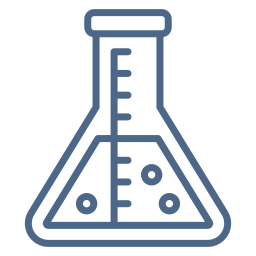Halogenated flame retardants
Certified reference standards prepared by Wellington LaboratoriesHalogenated flame retardants, classified as persistent organic pollutants (POPs), are potentially dangerous to health and the environment. They are therefore subject to strict regulations and continuous monitoring.
Our reagents enable these substances (HBCD, PBCD, TBBPA, DBDPE and others) to be analysed accurately, reliably and in compliance with international standards.
Our reference standards for analysing flame retardants and other related compounds
Wellington Laboratories ‘ reference standards are designed for public and private laboratories, organizations and professionals who need to identify halogenated flame retardants present in various media.
Flame retardants are flame-retardant chemicals used in the manufacture of materials that require increased protection against fire and heat. The most commonly used is brominated flame retardants (BFRs), which account for 30% of all flame retardants.
Halogenated flame retardants are persistent organic pollutants (POPs) that are potentially dangerous to health and the environment, and are subject to increased regulation and monitoring.
Many flame retardants exist and scientists continue to identify new ones. In fact, certain compounds have been created to replace others that are considered dangerous to health. These include:
- Polybrominated diphenyl ethers (PBDEs) are found in plastics, textiles, electronic moldings and printed circuits;
- Polybrominated biphenyls (PBBs) are used in household appliances, textiles and plastic foams;
- Hexabromocyclododecane (HBCDD) used for thermal insulation in the building industry;
- Tetrabromobisphenol-A (TBBPA) and other phenols, notably found in printed circuit boards and thermoplastics (mainly used in televisions);
- Dechlorane Plus® is a polychlorinated flame retardant widely used to replace PBDEs. Its main applications are electronic cables and wires, household appliances and plastic construction materials.
- Hexabromobenzene (HBBZ) and pentabromobenzene (PBBZ),
- Finally, this section also contains standards for compounds related to the use of HFRs, namely : Brominated/chlorinated dibenzo-p-dioxins (PBDDs) and dibenzofurans (PBDFs),
- Phosphorus compounds,
- Certain benzoates, phthalates and tetrabromobisphenols.
Wellington Laboratories’ reagents enable these analyses to be carried out accurately, reliably and in compliance with international standards.
BCP Instruments is the exclusive distributor of the entire range for France and Belgium.
To help you carry out your halogenated flame retardant analyses, we offer you all the references in the Wellington catalog, which you can consult online or download in PDF format. Contact us using the form below to obtain a quote.
Our range of HFR standards and other related compounds:
- Native isomers of hexabromocyclododecane (HBCDs)
- Native hexabromocyclododecane solution/mixture
- Native enantiomers of hexabromocyclododecane
- 13C-labelled hexabromocyclododecane isomers
- Deuterated hexabromocyclododecane isomers
- 13C-labelled hexabromocyclododecane solution/mixture
Pentabromocyclododecene (PBCD)
- Native pentabromocyclododecene (PBCD)
Tetrabromobisphenol-A (TBBPA)
- Tetrabromobisphenol-A (TBBPA): native and mass-labelled
Decabromodiphenyl ethane (DBDPE)
- Decabromodiphenylethane (DBDPE): native and mass-labelled
1,2-Bis(2,4,6-tribromophenoxy)ethane (BTBPE)
- 1,2-Bis(2,4,6-tribromophenoxy)ethane (BTBPE): native and mass-labelled
Hexabromobenzene (HBBZ)
- Hexabromobenzene (HBBZ): native and mass-labelled
Pentabromobenzene (PBBZ)
- Pentabromobenzene (PBBZ): native and mass-labelled
Other brominated compounds
- Pentabromoethylbenzene (PBEB)
- Pentabromotoluene (PBT)
- Tetrabromo-p-xylene (pTBX)
- 1,2,5,6-Tetrabromocyclooctane (TBCO)
- Tetrabromoethylcyclohexane (TBECH)
- Isomeric solutions/mixtures of tetrabromoethylcyclohexane
- Octabromotrimethylphenylindane
- Bis(2-ethyl-1-hexyl)tetrabromophthalate (BEHTBP): native and mass-labelled
- 2-ethylhexyl-2,3,4,5-tetrabromobenzoate (EHTBB): native and mass-labelled
- Hexachlorocyclopentenyl-dibromocyclooctane (HCDBCO)
- Tetrabromo-o-chlorotoluene
- Pentabromobenzyl acrylate
- 2,4,6-tribromophenyl ethers
Dechlorane Plus®
- Dechlorane Plus®
- Mass-labelled Dechlorane Plus®
- Dechlorane Plus® dechlorinated
- Dechlorane Plus® mono-adducts
Experimental flame retardants (EFRs)
- Tris(2,3-dibromopropyl)isocyanurate
Brominated acids and anhydrides
- 2,3,4,5-tetrabromobenzoic acid: native and mass-labelled
- 2,3,4,5-methyltetrabromobenzoate
- Tetrabromophthalic anhydride: native and mass-labelled
- Native organophosphorus compounds
- Mass-labelled organophosphorus compounds
- Brominated dibenzo-p-dioxins (PBDDs): native and mass-labelled
- Native bromo/chloro Dibenzo-p-dioxins
- Mass-labelled bromo/chloro dibenzo-p-dioxins
- Native brominated dibenzofurans (PBDFs)
- Native bromo/chloro dibenzofurans
- Mass-labelled bromo/chloro dibenzofurans
Consult the documentation below or write to us using the contact form. We’ll be delighted to advise you.
Wellington Reporter & Catalogue





PFAS, per- polyfluoroalkyl Substances

Halogenated flame retardants, HFRs and other compounds

Polychlorinated biphenyls, PCBs

Polybrominated diphenyl ethers, PBDEs Polybrominated biphenyls, PBBs

Dioxins, Furans, PCDDs, PCDFs

Organochlorine Pesticides, OCP

Certified reference materials

Other reagents
Find out more about flame retardants
What are RFHs?
Halogenated flame retardants (HFRs) are chemical compounds added to many consumer products to reduce their flammability. They break down rapidly when exposed to heat, releasing halogenated radicals that inhibit combustion.
Because of their lipophilic properties, most HFRs are able to accumulate in fat. In addition, these substances tend to be persistent and bioaccumulative, meaning that they can contaminate the environment, including air and water, and accumulate in humans and animals. For example, traces of these substances can be found in breast milk or in the air in the Arctic. It has also been shown that the degradation of these substances produces dioxins and furans.
Uses of flame retardants
These compounds are commonly used in a variety of consumer products, including building materials, electronic and electrical equipment, textiles and plastics.
However, the use of flame retardants in furniture has recently come in for criticism due to their limited effectiveness in fighting fires and the potential health risk from exposure to these substances. Slowing combustion can increase the release of toxic gases.
It is important to note that although these compounds are effective as flame retardants, some of them are suspected of being toxic. As a result, there are a multitude of flame retardants available, and researchers continue to identify and develop new alternatives. In fact, certain compounds have been specifically designed to replace other flame retardants considered to be dangerous to health.
HFRs regulations
European Directive 2002/95/EC has played a crucial role in restricting the use of flame retardants that present risks to reproduction, environmental persistence or neurotoxicity. Some of them have even been identified as endocrine disrupters.
Specific flame retardants, such as PBDEs, have been banned in France for several years. However, their presence persists in the environment.
In France, regulations on flame retardants are fairly strict. The M1/B1 standard corresponds to current European regulations on flame retardants for furnishing fabrics.
Do you need laboratory equipment and/or consumables?
Feel free to contact us at any time.
